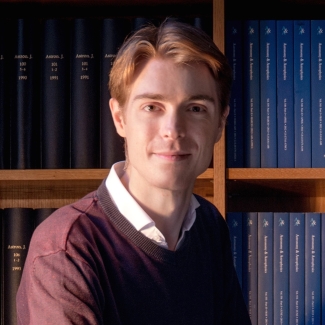
organizational unit
Akademie-Kolleg
Karlstraße 4
69117 Heidelberg
Curriculum Vitae
Academic Record
2023-now: Head of Research at an R&D Lab developing self-improving, decentralised AI
2022-now: Co-founder, Cosmic Origins Of Life (COOL) Research DAO, coolresearch.io
2022-now: Elected Chair & Spokesperson (Natural Sciences) of the Young Academy of the Heidelberg Academy of Humanities and Sciences
2023-2024: ERC Starting Grant Research Group Leader, Technical University of Munich
2017-2024: ERC Starting Grant Holder, European Research Council
2022-2023: Chief Data Officer at an AI-oriented enterprise
2016-2022: Emmy Noether Research Group Leader, German Research Foundation
2016-2022: Visiting Scientist, Max Planck Institute for Astronomy, Germany
2015-2016: Gliese Fellow & Research Group Leader, Heidelberg University, Germany
2012: Visiting scientist at the Institute of Astronomy, University of Cambridge, UK
2011-2015: MPA Postdoctoral Research Fellow at the Max-Planck Institut für Astrophysik, Garching bei München, Germany
2007-2011: NWO Toptalent PhD Fellow at Utrecht University, The Netherlands
2009: Visiting PhD student at the Institute of Astronomy, University of Cambridge, UK
2007-2011: Visiting PhD student at Leiden Observatory, The Netherlands
Awards & Distinctions
2022: Pastor Schmeits Prize, Royal Netherlands Astronomical Society
2020: Emmy Noether Extension Grant, German Research Foundation
2020: Academy Prize, Heidelberg Academy of Humanities and Sciences
2018: Individual Research Grant, German Research Foundation
2017: Hengstberger Prize, Hengstberger Foundation & Heidelberg University
2017: Ludwig-Biermann Prize, German Astronomical Society
2017: ERC Starting Grant, European Research Council
2016: Emmy Noether Research Grant, German Research Foundation
2015: Gliese Fellowship, Heidelberg University
2013: Christiaan Huygens Prize, Dutch Royal Academy of Sciences
2011: Postdoctoral Research Fellowship, Max Planck Institute for Astrophysics
2011: PhD in Astrophysics, Cum Laude, Utrecht University
2007: NWO Toptalent PhD Fellowship
Selected publications and lectures
Publication Summary
Total of >280 peer-reviewed articles, >18,000 citations, >280,000 reads, h-index of 77, m-index of 4.3, riq-index of 320 (link)
First author of 29 peer-reviewed articles, >3700 citations total, 14 of these have >100 citations (link)
First or second author on 4 articles in Nature or Nature Astronomy in 2019 and 2020
Author of 12 major review articles (first, second, or third author on 5 of these)
Communication Summary
>80 media/public outreach appearances (TV, radio, lectures); 16 press releases; >170 scientific talks in 20 countries (>75 invited)
List of 15 Highlight Publications
- The Formation of Globular Clusters
Kruijssen, J. M. D., Elsevier Encyclopedia of Astrophysics, in press, arXiv:2501.16438 (2025) - COOL Research DAO Whitepaper — Towards community-owned astrophysics for everyone
Chevance, M., Kruijssen, J. M. D. & Longmore, S. N., arXiv:2501.13160 (2025) - Empirically motivated early feedback: momentum input by stellar feedback in galaxy simulations inferred through observations, Keller, B. W., Kruijssen, J. M. D. & Chevance, M., MNRAS 514, 5355 (2022)
- Pre-supernova feedback mechanisms drive the destruction of molecular clouds in nearby star-forming disc galaxies, Chevance, M., Kruijssen, J. M. D., et al., MNRAS 509, 272, (2022)
- Kraken reveals itself – the merger history of the Milky Way reconstructed with the E-MOSAICS simulations, Kruijssen, J. M. D., Pfeffer, J. L., Chevance, M., et al., MNRAS 498, 2472 (2020; press release)
- The lifecycle of molecular clouds in nearby star-forming disc galaxies, Chevance, M., Kruijssen, J. M. D., et al., MNRAS 493, 2872 (2020)
- The formation and assembly history of the Milky Way revealed by its globular cluster population, Kruijssen, J. M. D., Pfeffer, J. L., Reina-Campos, M. et al., MNRAS 486, 3180 (2019)
- The E-MOSAICS Project: tracing galaxy formation and assembly with the age-metallicity distribution of globular clusters, Kruijssen, J. M. D., Pfeffer, J. L., Crain, R. A. & Bastian, N., MNRAS 486, 3134 (2019)
- Fast and inefficient star formation due to short-lived molecular clouds and rapid feedback, Kruijssen, J. M. D., Schruba, A., Chevance, M., Longmore, S. N., et al., Nature 569, 519 (2019, press release)
- An uncertainty principle for star formation - II. A new method for characterising the cloud-scale physics of star formation and feedback across cosmic history, Kruijssen, J. M. D., Schruba, A., Hygate, A. P. S., et al., MNRAS 479, 1866 (2018)
- The E-MOSAICS project: simulating the formation and co-evolution of galaxies and their star cluster populations, Pfeffer, J., Kruijssen, J. M. D., Crain, R. A. & Bastian, N., MNRAS 475, 4309 (2018)
- Globular clusters as the relics of regular star formation in ‘normal’ high-redshift galaxies, Kruijssen, J. M. D., MNRAS 454, 1658 (2015)
- What controls star formation in the central 500 pc of the Galaxy?, Kruijssen, J. M. D., Longmore, S. N., Elmegreen, B. G., et al., MNRAS 440, 3370 (2014)
- An uncertainty principle for star formation. I. Why galactic star formation relations break down below a certain spatial scale, Kruijssen, J. M. D. & Longmore, S. N., MNRAS 439, 3239 (2014)
- On the fraction of star formation occurring in bound stellar clusters, Kruijssen, J. M. D., MNRAS 426, 3008 (2012)
Personal website: http://diederikkruijssen.com.

